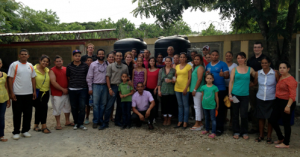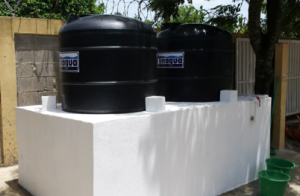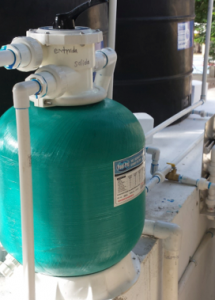Below is a detailed summary of what an Aqua Clara partner has done in the Dominican Republic:
Water Supply in Developing Countries:
Development of a Community-Scale Water Treatment System in the Dominican Republic
Course Co-Listed as: CE 597, BIOL 595, NUR 599, AGEC 595
Introduction
Lack of access to potable water is a chronic problem for approximately 800 million people (roughly 1/9th of the world’s population), leading to increased rates of morbidity and mortality among people of many developing countries. These effects tend to be most pronounced among women and children, who often have responsibility for collection of water in developing countries. Sustainable solutions to water supply and sanitation problems in developing countries require a holistic approach.
To address this issue, a, interdisciplinary service-learning class was initiated in the Fall 2012. The objective for this service learning class is to design, build, and implement community-scale water treatment systems for communities in a developing country. For the foreseeable future, target communities will be in the Dominican Republic (DR). Work on this project has involved coordination with Aqua Clara International (Holland, MI), a non-profit organization who works to provide affordable safe water solutions for communities in developing countries. Rotary International has also been helpful in identifying communities to work with, and in connecting the project team to community leaders in the DR.
Based on communications with project partners, the town of Las Canas, DR was selected as the location for a pilot system. It is anticipated that the lessons learned in implementing the system at Las Canas will allow for other, similar systems to be designed, built, and implemented in other communities in the DR, and perhaps in other countries.
Course Instructors
Ernest R. Blatchley III, Ph.D., P.E., BCEE (blatch@purdue.edu)
Professor, Lyles School of Civil Engineering and Division of Environmental & Ecological Engineering
Vicki L. Simpson, PhD, MSN, RN, CHES, Clinical Assistant Professor (vsimpson@purdue.edu)
School of Nursing
Kenneth A. Foster, Ph.D. (kfoster@purdue.edu)
Professor and Head, Department of Agricultural Economics
Bruce M. Applegate, Ph.D. (applegate@purdue.edu)
Associate Professor, Department of Food Science and Department of Biological Sciences
Project Partners and Funding
As mentioned above, this project has been conducted as a collaborative effort with Aqua Clara International (ACI), who are “a non-profit corporation whose mission is to develop science-based, sustainable, and scalable technologies that provide those who live on less than $2 per day with affordable, clean water” (https://aquaclara.org/). ACI has provided technical support for the project throughout. ACI also facilitated contact with members of Rotary clubs in the DR, which led to our introduction to Antonio (Tony) Peña, who is a community leader in Las Canas that has played several crucial roles in facilitating this project.
Funding for the project has come from a number of internal and external sources. Seed funding for this project came from a grant from the US EPA, under their People, Prosperity, and Planet (P3) Program. Support has also been provided in the form of grants from participating academic units at Purdue University (Agricultural Economics, Civil Engineering, Food Science, and Nursing), as well as program offices at Purdue University (Global Engineering Program [GEP] and Purdue Water Community [PWC]). Students in the class have played very active roles in acquiring financial support for the project. Perhaps most notable among these efforts have been two successful proposals to the Hydrologists Helping Others (H2O) Program, which is operated through the Department of Earth, Atmospheric, and Planetary Sciences at Purdue University. Funding from these and other sources has been used to support the costs of travel to the DR, acquisition of supplies to conduct experiments, and construction of the actual water treatment system in Las Canas, all of which are described below.
Within the DR, project activities have also involved several organizations. Community members in Las Canas have organized a governance board (El Patronato) to determine how the system will be operated, both in terms of day-to-day operations and with respect to the business and economic issues. The system at Las Canas has been built at the Ana Julia Diaz Luna School (Ana Julia School); the school is centrally-located within Las Canas, and also serves as a social hub for the community. Project participants have also coordinated collaboration with Universidad Católica Tecnológica del Cibao (UCATECI), in La Vega, DR. UCATECI students will be involved in regular monitoring of water quality at the Ana Julia School; we anticipate that these students will also participate in similar monitoring efforts at other community-scale water treatment systems that are developed as outcomes of this class.
A proposal was written to the Hach Company as a request for analytical equipment to support the project. Hach provided a portable turbidimeter and a portable device to measure residual free chlorine in water.
Project/Class History
The class has operated as a hybrid learning setting, involving conventional classroom lectures, laboratory-based experiments, field measurements and surveys, and construction/implementation of the system. This integrated approach was applied to allow the class to work toward the goal of implementing a sustainable water treatment system at Las Canas. Brief descriptions of major project/class activities are presented below.
- Class Meetings: Regular class meetings began with lectures to introduce basic principles of each of the participating disciplines, as related to the project.
o Biology – Waterborne, microbial pathogens and the diseases they cause in humans
o Economics – Principles of entrepreneurship and governance
o Engineering – Potable water production (multiple-barrier concept) and measurements of water quality
o Nursing – Public health and hygiene
- Laboratory Experiments: Students conducted experiments to define the fundamental behavior of individual system components. These included measurements of flow rate as a function of applied pressure (head) through physical separation processes, and measurements of particle and bacterial removal/inactivation across system components.
- Visits to Las Canas: Students and faculty have traveled to the DR on four occasions to work with community-members in Las Canas and other project partners.
o March 2013 – This first visit to the DR was intended largely as a reconnaissance trip. Project participants from Purdue met with community leaders and residents in Las Canas. These meetings, as well as the results of a survey that had been conducted by and among Las Canas residents, allowed the Purdue team to learn about the local sources of water (ground water reservoir located roughly 50 m vertically upgradient from Ana Julia School, rainwater, and commercially-available bottled water). We also met with a local community health clinic, where the physician in charge informed us that roughly 40% of her patients suffer from illnesses associated with the water they drink (mostly diseases related to amoeba and protozoan parasites), and that roughly half of the female patients she saw experienced a rash that was linked to water exposure. The Purdue team met with students and faculty from UCATECI, who expressed interest in participating in the project. This trip also allowed the team to learn about construction materials that are available locally. The results of these meetings allowed for refinement of the system design as Las Canas. Specifically, the team defined the following sequence for production of potable water at the Ana Julia School, which adheres to the principles of the multiple-barrier concept:
Concrete Platform – The system was built on a reinforced concrete platform. The platform serves as a stable location for the system, and also ensures that finished water can be delivered to users from an elevation that is sufficient to allow water delivery by gravity-based flow (i.e., no pumping required). The platform was designed by a group of graduate students from the Structural Engineering group of the Lyles School of Civil Engineering, under the direction of Prof. Robert Frosch.
Sand filtration – A swimming pool (sand) filter is used as the first stage of treatment. This device, which is available locally in the Santiago, DR area, functions to remove large particles from water and to protect downstream processes.
Low-pressure membrane filtration – A hollow-fiber microfiltration system is included in the system. Two membrane modules are included, with nominal pore size openings of 0.2 µm. As such, this system is able to remove essentially all bacteria, protozoa, and other parasites from water.
Chlorination – Commercially-available liquid bleach is applied to accomplish inactivation of waterborne viruses (which are small enough to pass through the sand filter and the microfiltration membranes). Residual chlorine also is important for water stability and safe water storage.
o May 2013 – This second visit was used to meet again with residents of Las Canas to describe the steps needed to build and implement the system. In addition, project participants from Purdue University met with representatives from Children International (https://www.children.org/). CI operates several community centers in the DR (and other developing countries). These facilities have water needs that are similar to those of Las Canas and many other communities in the DR, and as such they represent potential locations of future water treatment systems.
o April 2014 – This third visit allowed for a meeting with the governance board (El Patronato) of Las Canas to discuss details of implementation, governance, and logistics of construction. El Patronato was formed as a group of community leaders to define financial, logistic, and governance policies for the system. In addition, members of the Purdue team were able to meet with representatives of Grupo Constructor del Caribe, which is a construction engineering firm located in Santo Domingo, DR. Grupo Constructor del Caribe agreed to perform the construction of the reinforced concrete platform that had been designed by the structural engineering group at Purdue University (see description above).
o June 2014 – The primary objective of this trip was to complete the construction and implementation of the water treatment system at the Ana Julia School. Prior to arrival of the Purdue team, a subcontractor of Grupo Constructor del Caribe completed the construction of the reinforced concrete platform described above (see Figure 1). Other components of the system were shipped to the DR through Grupo Constructor del Caribe or purchased locally by the project team. Figures 2-5 illustrate the basic components of the completed water treatment system. A local plumber was hired by the project team to install the system. Also during this trip, project participants worked with Las Canas residents and members of El Patronato to conduct a follow-up survey of socio-economic and public health conditions in the community. Additional meetings were held with El Patronato to finalize governance and business issues related to the project. It is important to note that the Purdue team served in an advisory capacity to El Patronato; all decisions related to the operation and governance of this system are made by El Patronato. An additional meeting was held with administrative representatives from UCATECI to discuss participation in the project. The trip concluded with a “ribbon-cutting” ceremony at the Ana Julia School in which community members and representatives from Purdue University sampled the product water from the system (see Figure 6 below).
Future Activities
Completion of construction and implementation of the system at the Ana Julia School represent important milestones for the class/project; however, they do not represent an endpoint. The Las Canas project will remain active for the foreseeable future as we work with our project partners in the DR to monitor system performance, and to complete follow-up surveys in the community.
As described previously, the Las Canas project was designed as a pilot effort. Our plan as a team was to use the lessons learned in this project to inform implementation of additional systems in DR in communities that face water problems that are similar to those of Las Canas. In our trips to the DR, and in communication with our project partners there, we have been able to identify other communities where similar systems are needed. Therefore, our goals for this project as we move forward are to design, build, and implement similar systems in the DR to provide safe, affordable water in a manner that is sustainable. Candidate communities include: the town of La Torre, which is immediately adjacent to Las Canas, and another school in the area: Escuela Reparadero. In addition, several facilities operated by Children International could be used as the next location for such a system.





 English
English Spanish
Spanish